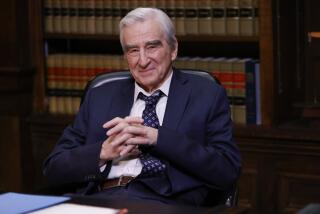The Violent Life of Boxer Kid McCoy
- Share via
His outrageous cheating in the boxing ring--like spraying ammonia in one opponent’s eyes and strewing thumbtacks under the bare feet of another--ironically made him a glamorous sports figure. But in the world outside the ring, his temper was notorious, and between his eighth and ninth wives, he killed his girlfriend.
His moniker is still in the American vocabulary: The Real McCoy.
At the turn of the century, Norman Selby boxed as “Kid McCoy,” a world middleweight and welterweight champion whose opponents included Gentleman Jim Corbett--though McCoy was definitely no gentleman.
*
Famed for his “corkscrew punch,” it was his underhanded tactics that made him popular. Against a deaf boxer, he pointed to the man’s corner, indicating that the bell had ended the round. It hadn’t. When the man turned away, McCoy knocked him cold.
McCoy said his name “The Real McCoy” came about thusly: “I’m in a saloon with a charming young lady, as usual. A drunk is making passes at her. I try to brush him off without too much fuss. Beat it, I says, I’m Kid McCoy. He laughs and says, ‘Yeah? Well, I’m George Washington.’ I have to clip him a short one and down he goes. He wakes up 10 minutes later, rubs his jaw, and says, ‘Jeez, it was the real McCoy!’ ”
His retirement in 1897 lasted three years. In 1900, he fought against Corbett, who knocked him out. It was one of six losses in his 166-fight career.
More often, he lost his temper. Saloon slugfests increased as his fame waned. And then, in 1924, he came to Los Angeles.
His fortune gone after eight divorces, McCoy, a flabby 51, played bit parts in movies as the bad guy. He started dating Theresa Mors, whose husband, Albert, was a wealthy art and antiques dealer. Theresa moved in with McCoy, recalled 92-year-old Frances Pearlstein Grunnet, the Morses’ former secretary and the only surviving witness to what would occur. She gave this account:
Theresa’s friends Sam and Ann Schapp, who owned a dress shop next to the antiques store, told her that McCoy was a bum.
On Aug. 12, 1924, McCoy came home drunk. When Theresa told him what her friends thought of him, he knocked her teeth out, stabbed her and shot her in the head. McCoy drank all night and, by the next morning, wanted to kill Albert Mors too.
Mors wasn’t at his shop when McCoy got there, so he kept 11 people hostage while he waited. He ordered three men to take off their pants to discourage escape. (One left anyway, and McCoy shot him in the leg.)
One of the hostages was 19-year-old Frances.
McCoy gathered up the hostages’ money, giving $300 to the soon-to-be-married Frances as a wedding gift. (She later returned it to its owners.)
Her boss, Albert, “never showed up,” she said in a recent interview. “He was off getting a haircut and then his new Cadillac wouldn’t start, which saved his life.”
Frustrated by the wait, McCoy went in search of the Schnapps. He shot and wounded them before racing through what is now MacArthur Park, where police caught him.
*
Theresa Mors had died wearing two long ropes of pearls, a diamond watch, and an emerald and diamond ring. But when her body was found, the jewelry was gone. When Albert Mors’ friend, the county coroner, invited Mors to a seance, Mors took Frances along.
“When it was Albert’s turn to speak, he asked his dead wife’s spirit what happened to her jewelry. A woman’s voice sounding like Theresa said it was in a safe deposit box at Citizens Bank on Spring Street under McCoy’s sister’s name.” It was.
McCoy’s attorney, Jerry Giesler, persuaded the jury to convict the former boxer on manslaughter, not murder, charges.
McCoy served eight years of a 24-year sentence. Working on a chain gang near San Simeon, he saved an injured pilot from the wreckage of a plane that crashed nearby. That led to a better job as a tour guide at San Quentin.
In 1932, the 59-year-old parolee and his new, ninth wife moved to Detroit, where McCoy became “athletic director” for Ford Motor Co. Three years later, he rescued several people whose boat had overturned on Lake Michigan. (California’s governor pardoned him at the behest of celebrities that included Gen. Douglas MacArthur, actor Lionel Barrymore and U.S. Vice President Charles Curtis, according to reports in The Times.)
But in 1940, at 66, he took a bottle of sleeping pills and died. His farewell note read, “I can’t endure this world’s madness any longer.”
McCoy had once warned a young inmate, “Remember that the bright lights go out the quickest. Kid McCoy knows.”
More to Read
Go beyond the scoreboard
Get the latest on L.A.'s teams in the daily Sports Report newsletter.
You may occasionally receive promotional content from the Los Angeles Times.










